
Plums fruit on an old tree near where a farm cottage once stood in Bartsh Road, south of Beechworth, not far from the Blume farm [2014].
Frederick Blume was born the son of farmers Christian and Catherine Blume in Leimberg in Hanover in 1842 and was 19 when he left Germany with a friend with the hope of making Australia. According to Beechworth historian and author Joan Hilderbrand, in Liverpool the two young men stowed away on a ship from which they disembarked in Melbourne in 1862. After mining for a time in New Zealand, Frederick returned to Australia and came to the Woolshed Valley near Beechworth. He married in 1872 Mary Louisa Cox in Beechworth’s Anglican Christ Church, which is as you see it today, with its Early English Gothic-influenced square stone tower.

Kelly historians Matt Shore (right) and Darren Sutton near the place where Aaron Sherritt was murdered in the Woolshed Valley by Joe Byrne and Dan Kelly in June 1880 [June 2015].

Blume farm cottage, believed to have been built by Chinese miners in the 1860s, and its separate kitchen in the garden [2014].
It was after the move to the Three Mile that another 10 children were born to Frederick and Louisa. With their mother, the four whose lives remained intertwined with the story of our house and garden were Francis or Frank, born in 1882, Florence, in 1885, Alvina – known as ‘Topsy’ – in 1895, and George, in 1898.
The Blume farm – on which Topsy for probably eight decades of her long life husbanded and milked a small herd of Jersey cows and tended her much loved garden – is rare, if not unique, in the North East and perhaps Victoria.
Thanks to the Bartsh family, our neighbours, who bought the property from Topsy in 1971 while agreeing to her life-tenancy, it remains preserved as it was 150 years ago – intact, secure and protected.
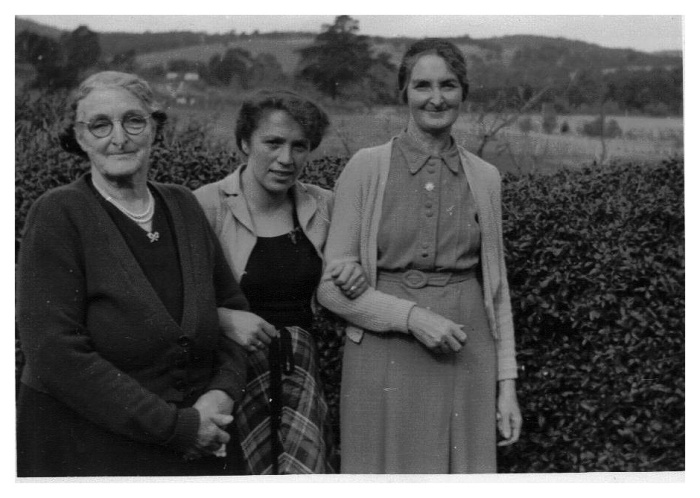
Florence Blume, Lisa (Mielitz) Peter and Alvina Blume in the garden at Weir Lane [c. 1950]. Image: Gitte Curnow.
The English poet and gardener Vita Sackville West, who was three years older than Topsy, plumbed this sense in her epic 1926 narrative work, The Land:
I sing once more
The mild continuous epic of the soil,
Haysel and harvest, tilth and husbandry;
I tell of marl and dung, and of the means
That break the unkindly spirit of the clay;
I tell the things I know, the things I knew
Before I knew them, immemorially…
‘We used to have cows and milk them,” Topsy told Border Morning Mail reporter Chris Hornsey in an interview which she gave him in 1981, when she was 85. “We used to sell our cream in Wangaratta.”
With her sister Florence – known as ‘Cookie’ because of her exceptional baking skills – Topsy lived in their parents’ cottage, with its kitchen in a building separate from the cottage living and bedrooms, for their entire lives.

Gitte Mielitz in the garden at Weir Lane [c. 1950]. Image: Gitte Curnow.

A window at Blume cottage [2014].
The Blume garden was watered throughout the sisters’ lives with water from the well. It remains today under a corrugated iron roof held up with bush timber, and drops away beneath a well-housing, featuring double doors, that covers the windlass.
“It’s not an easy job,” Tospy told the Border Mail, “particularly in the summer months when the level of water drops considerably.” The heavy iron bucket is lowered into the water and, when filled, wound up again by hand. “It’s down to 17 turns at the moment and it will get down to 22,” she said. In the summer of 1981 she was drawing water three times a day, as she went on to tell the journalist, “because I have to water the flowers”. She recalled that at one time she drew up a live snake in the bucket. “You have to get them out,” she said, “or they rot in the water (and taint it)”.
It was through another well by which the lives of Florence, Topsy, Frank and George Blume and their mother Louisa became tragically enmeshed with that of their neighbour, Margaret Ryan, and her disabled daughter, Violet, in 1931.

Weir Lane cottage, thought have been built about 1860, with Lisa (Mieltiz) Peter on the verandah [c. 1950]. Image: Gitte Curnow.

Frosted grass at Weir Lane [2015].
It read –
Baarmutha, 31 Aug, 1931
Dear Mrs Blume,
Would you mind keeping Violet with you until someone takes her as I am going to end my life. My body will be found in the well. Would you mind sending for Jack (her son) and tell Mr Kelly to come with him. I can’t stand the worry any longer. My head is very queer. Don’t let her (Violet) come home by herself at any time – poor girl, God help her. I hope they will be good to her who takes her.
Farewell my dearest friend
Sincerely, ever loving friend,
M. Ryan
In a postscript she wrote:
I am sending one pound. Jack will give you more if she (Violet) is with you longer than a week. Florrie can take the cow up there (to you, the Blumes) to milk until they can see what they will do with her.
And in margin of the letter she added –
Ask Frank (Blume) to send for the police, as they can’t touch me until they come.
At the inquest the next day, the coroner also was shown a letter written by Margaret to Jack –
My dear son and all my dear children, it is with a sad heart I am writing these few lines to you. I hope God will forgive me for taking my life in such a manner – also all of you, my dears. But I have a feeling something dreadful is going to happen to me and I think this is the best way out of all my troubles…. Poor Vi, I wish I could take her with me but that can’t be. God help you all – and forgive me for what I have done.
Mother
Violet died in Sydney’s Parramatta Psychiatric Centre in December 1966. She was 67.
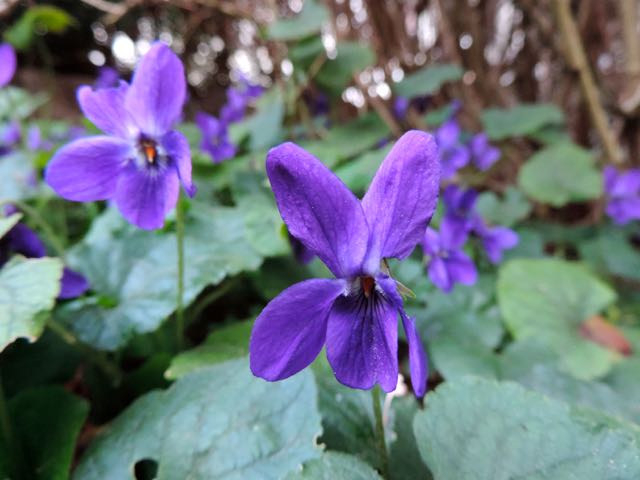
Violets grow in profusion in the garden at Weir Lane [2014].
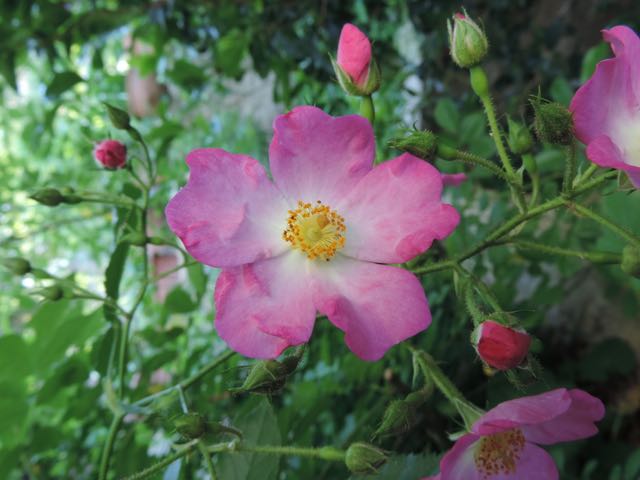
This lovely but unidentified pink-lilac rose grows near the well where Margaret Ryan lost her life [2015].
Weir Lane was sold by Jack Ryan to Frank Blume within a few months of his mother’s death and in 1938, on Frank’s death, it was inherited by his sister Topsy.
It was into the lives of this hard-working woman and her housekeeping sister, Florence, that the young German-born Gitte Mieltiz came in 1949 as someone akin to a grand-daughter.
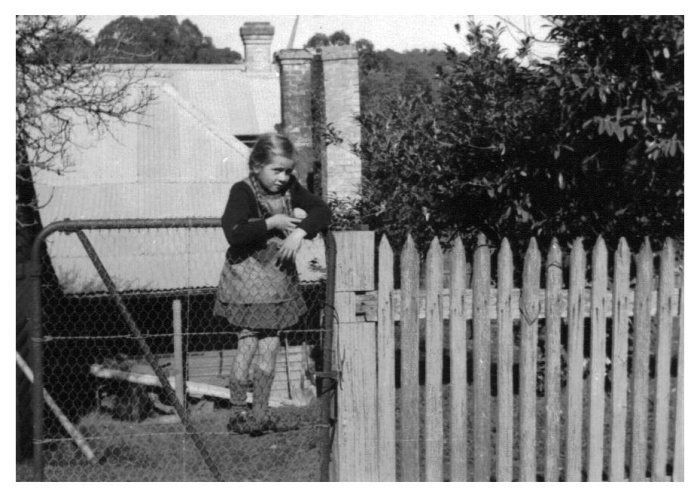
Gitte Mielitz on the back gate in the garden at Weir Lane [c.1950]. The tree branches at left at are of a mulberry that continues to prosper and fruit to this day. At right is a large cherry laurel Prunus laurocerasus which also remains. Image: Gitte Curnow.
Me on the back gate – presumably your back boundary too. The bare branches (photo taken in winter) at the top left hand of the photo was a mulberry tree. The house viewed from the back is behind me… One can see the original section of the house at chimney furtherest away… The dark skinny long triangle on the left of the photo looks like the kitchen roof. The back of the house had a covered breezeway between the house proper and the kitchen, as can be seen behind me – although I don’t remember it.

The Weir Lane mulberry tree with Acer palmatum behind it [2015].

Electricity blackouts in 1981 posed no problem for Alvina ‘Topsy’ Blume, 85, near Beechworth. Miss Blume has her kerosene lamp for illumination. [Published July 6, 1981. Photo: Peter Mayoh, ‘Reflections 150 Years of The Age‘].
Tops was a hard worker. Didn’t go out shooting or mending fences, but did all the dairy work (separating), feeding the poddy calves, pigs, hens, and some housework, and lots of crocheting of an evening. I don’t think she knew how to relax. She worked for a while as a young woman in Castlemaine, but some time after her sweetheart died in the Great War 1914-18 she returned to (Three Mile). The milking was done by George and Tops – maximum 24 cows – and when the going got tough, Granny (Florence) also milked a few. They taught me how to milk cows and I could manage 2-3 maximum of the easy milkers before my fingers wore out. Granny cooked the food and had a somewhat easier lifestyle. Tops occasionally took me on afternoon walks across the paddocks, or to…visit one or two neighbours for afternoon tea. Granny wasn’t up to walking any distance, or across paddocks.

Gitte (Mielitz) Curnow at the Blume cottage [July 2014].
But there is one recollection of Gitte’s which, in its way, becomes a thread through all of our diverse lives – from Frederick and Louisa Blume, their children, through their neighbour Margaret Ryan, who owned our house and garden, to Gita who lived there as a small girl in what was to her a strange land, to Peter and me who now live at Weir Lane, and to each of you who has done Beechworth a great privilege by coming here with your keen interest in our shared heritage and our gardens, and listening to this story.

Cattle grazing in the paddock surrounding Blume cottage with its oak and cypress towering in the garden [May 2016].
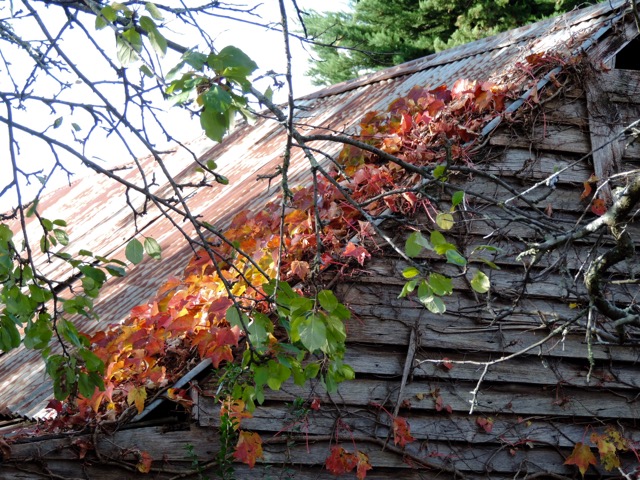
Boston ivy turns the season on Blume cottage roof [May 2016].
AUSTRALIAN GARDEN HISTORY SOCIETY
This presentation was made to the Australian Garden History Society Victorian branch autumn 2016 tour – Autumn leaves and private gardens – by the author at Beechworth’s George Kerferd Hotel on April 30, 2016. Images: Jamie Kronborg [unless otherwise attributed].
Florrie and Topsy were my mother’s aunts. Gardening is a passion that runs deep in the Blume family. They all had delightful gardens, full of surprises. And it’s still going strong among many of the descendants.
Thanks for the article and the wonderful pictures. I only visited once, when I was young, but it made quite an impression. It was a step back in time. Topsy was living alone by then, and after she had made us lunch (she insisted) she confessed that that morning she had fallen when getting water from the well and her arm was hurting a little. Turned out it was broken. Yes, she was tough!